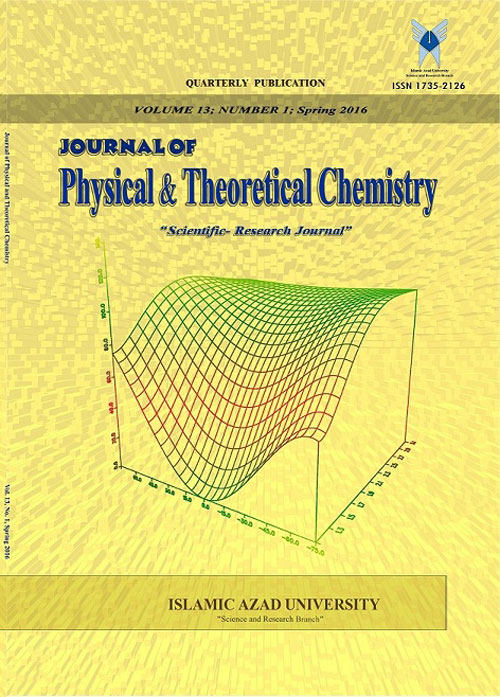فهرست مطالب

Journal of Physical and Theoretical Chemistry
Volume:2 Issue: 4, Winter 2006
- تاریخ انتشار: 1384/11/12
- تعداد عناوین: 6
-
Pages 1-12In this paper we have solved analytically the Schrödinger equation for a microscopic particle in a one-dimensional box with two infinite walls, which the potential function inside it, has a linear form. Based on the solutions of this special quantum mechanical system, we have shown that as the quantum number approaches infinity the expectation values of microscopic particle position and square of the linear momentum are equal to the classical time average of particle position and its square of the linear momentum, respectively.Keywords: One-dimensional Schrodinger equation, Bessel generalizeddifferential equation, Bessel functions of fractional order, Integrals of Besselfunctions, Second Lommel integral
-
Pages 13-26The interaction of hGH with some metal ions ( ) at 27°C in NaC1 solution, 50 mM was studied using Isothermal titration calorimetry. There is a set of three identical and non-interacting binding sites for binding of all these metal ions, expect . The intrinsic association equilibrium constants () are not very different for and , and also their molar enthalpies of binding (KJ/mol for and KJ/mol for ) are similar showing same thermodynamical properties for hGH upon interaction with both and . Thermodynamical properties for hGH upon interaction with both is completely different from those of and . The affinity of binding is the highest (), but the molar enthalpy of binding is the lowest () for . There is a set of four identical and independent binding sites for . The binding process for iron ions is more exothermic (KJ/mol) than other three metal ions and with a higher affinity () respect to andKeywords: Isothermal titration calorimetry, human growth hormone, Calcium, Magnesium, Copper, Iron (III)
-
Pages 27-32The kinetic of photo oxidative decolorization of C.I. Acid yellow 23 (AY23) was investigated in UV/ process. The semi-logarithmic of the concentrations of AY23 versus irradiation time were linear, suggesting pseudo-first order reaction. A simple kinetic model is proposed which confirms pseudo- first order reaction. The results indicate that the apparent reaction rate constant is a function of light intensity, and AY23 initial concentrations. These results are in good agreement with proposed kinetic model.Keywords: Advanced oxidation processes (A0Ps), Photooxidation, UW1-1202, C.I. Acid Yellow23, Kinetic model
-
Pages 33-40A catalytic-kinetic method for the determination of selenium is proposed. Alizarin navy blue is reduced by sodium sulfide to from a colorless product. The reaction is accelerated by trace amounts of Se (IV), and can be followed by measuring the decrease in absorbance of the dye at 620nm and 30 °C by the fixed time method. Selenium can be determined in the range of 0.004 — 0.12 1.1g.m1-1 . The detection limit is 0.03 ng.m1-1 Se (IV). The relative standard deviation for 0.08, and 0.11,tg.m1-1 : Se (IV) was 2.2%, and 1.8%, respectively. The method is free from most interferences and it was applied to determination of selenium in water real samples.Keywords: Selenium, Alizarin navy blue, Catalytic, Kinetic Method
-
Pages 41-48In the present study, the binding isotherms for interaction of a homologous series of n-alkyltrimethyl ammonium bromides with bovine serum albumin (BSA) have been analyzed on basis of intrinsic thermodynamic quantities. In this regards, the intrinsic Gibbs free energy of binding, AGb(i,)„ </em>has been estimated at various surfactant concentrations and its trend of variation for both binding sets have been interpreted on basis of cooperativity and hydrophobicity of process. Subsequently, the contribution of electrostatic and hydrophobic interactions in AG,, have been estimated using a published method which has been previously introduced by us for analysis of jack bean urease-cationic surfactant system. The results represent the favoring predominate role of hydrophobic interactions and inhibiting rule of electrostatic interaction in binding affinity of both sets. The predominate role of hydrophobic interactions in the second binding set can be related to entropy statistical effect, which arises from numerous number of binding sites in this set but it may be referred to large amount of positive charge density and accessible hydrophobic surface area of BSA in first binding set.Keywords: Bovine serum albumin, Cationic surfactants, Gibbs free energy of binding, Electrostatic interactions, Hydrophobic interactions
-
Pages 49-54A new method for the synthesis of water soluble Polyaniline (PANi) using Hemin Chloride (H.C) in the presence of hydrogen peroxide (H.P) is presented. Hemin chloride is an effective catalyst for the oxidative polymerization of aniline in the presence of hydrogen peroxide at room temperature. The UV- Vis absorption spectra of the product show a distinct absorption peak at 430 nm in pH 4.0 buffer solution, indicating the formation of Polyaniline. A new mechanism for polymerization of aniline in the presence of H.0 and H.P is also presented.Keywords: Polyaniline, Enzymatic Polymerization, Conducting polymer

